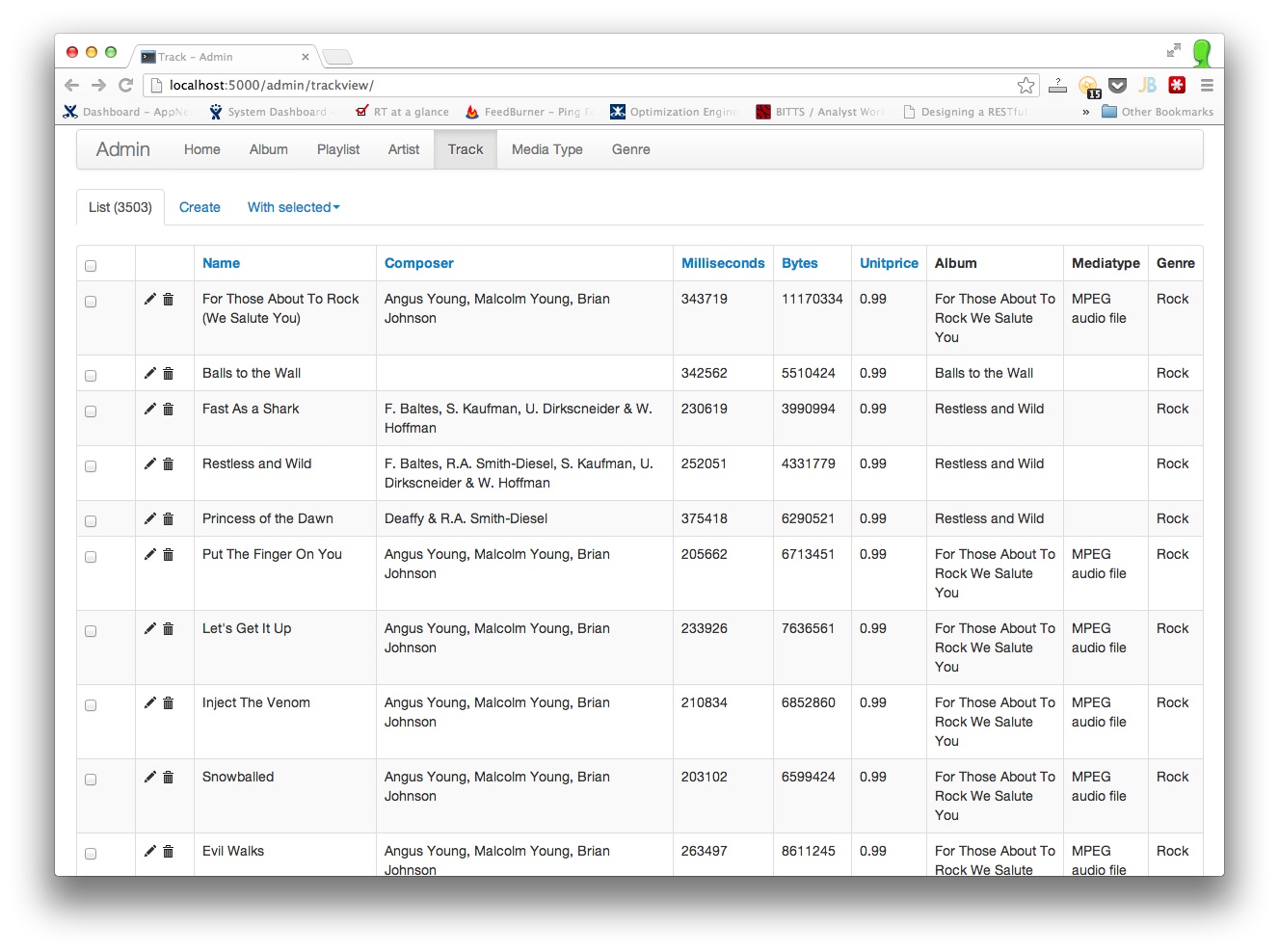Visit the home of sandman on the web: sandman.io
sandman "makes things REST". Have an existing database you'd like to expose via
a REST API? Normally, you'd have to write a ton of boilerplate code for
the ORM you're using, then integrate that into some web framework.
I don't want to write boilerplate.
Here's what's required to create a RESTful API service from an existing database using
sandman:
$ sandmanctl sqlite:////tmp/my_database.dbThat's it. sandman will then do the following:
- connect to your database and introspect its contents
- create and launch a REST API service
- create an HTML admin interface
- open your browser to the admin interface
That's right. Given a legacy database, sandman not only gives you a REST API,
it gives you a beautiful admin page and opens your browser to the admin page.
It truly does everything for you.
sandman, by default, supports connections to the same set of databases as
SQLAlchemy. As of this writing, that includes:
- MySQL (MariaDB)
- PostgreSQL
- SQLite
- Oracle
- Microsoft SQL Server
- Firebird
- Drizzle
- Sybase
- IBM DB2
- SAP Sybase SQL Anywhere
- MonetDB
sandmanctl is really just a simple wrapper around the following:
from sandman import app
app.config['SQLALCHEMY_DATABASE_URI'] = 'sqlite:///chinook'
from sandman.model import activate
activate()
app.run()You don't even need to tell sandman what tables your database contains.
Just point sandman at your database and let it do all the heavy lifting
Let's start our new service and make a request. While we're at it, lets make use
of sandman's awesome filtering capability by specifying a filter term:
> python runserver.py &
* Running on http://127.0.0.1:5000/
> curl GET "http://localhost:5000/artists?Name=AC/DC"...
{
"resources": [
{
"ArtistId": 1,
"Name": "AC/DC",
"links": [
{
"rel": "self",
"uri": "/artists/1"
}
]
}
]
}All of that, including filtering/searching, is automagically available from those five measly lines of code.
Oh, that's not enough? You also want a Django-style admin interface built
automatically? Fine. You may have noticed that when you ran runserver.py that
a browser window popped up. Now's the time to go check that out. You'll find
it's that Django-style admin interface you've been bugging me about, looking
something like this:
(If you want to disable the browser from opening automatically each time sandman
starts, call activate with browser=False)
If you wanted to specify specific tables that sandman should make available,
how do you do that? With this little ditty:
from sandman.model import register, Model
class Artist(Model):
__tablename__ = 'Artist'
class Album(Model):
__tablename__ = 'Album'
class Playlist(Model):
__tablename__ = 'Playlist'
register((Artist, Album, Playlist))And if you wanted to add custom logic for an endpoint? Or change the endpoint name? Or add validation? All supported. Here's a "fancy" class definition:
class Style(Model):
"""Model mapped to the "Genre" table
Has a custom endpoint ("styles" rather than the default, "genres").
Only supports HTTP methods specified.
Has a custom validator for the GET method.
"""
__tablename__ = 'Genre'
__endpoint__ = 'styles'
__methods__ = ('GET', 'DELETE')
@staticmethod
def validate_GET(resource=None):
"""Return False if the request should not be processed.
:param resource: resource related to current request
:type resource: :class:`sandman.model.Model` or None
"""
if isinstance(resource, list):
return True
elif resource and resource.GenreId == 1:
return False
return TrueWith sandman, zero boilerplate code is required. In fact, using sandmanctl,
no code is required at all. Your existing database
structure and schema is introspected and your database tables magically get a
RESTful API and admin interface. For each table, sandman creates:
- proper endpoints
- support for a configurable set of HTTP verbs
- GET
- POST
- PATCH
- PUT
- DELETE
- responses with appropriate
rellinks automatically- foreign keys in your tables are represented by link
- custom validation by simply defining
validate_<METHOD>methods on your Model - explicitly list supported methods for a Model by setting the
__methods__attribute - customize a Models endpoint by setting the
__endpoint__method - essentially a HATEOAS-based service sitting in front of your database
sandman is under active development but should be usable in any environment due
to one simple fact:
sandman never alters your database unless you add or change a record yourself. It adds no extra tables to your existing database and requires no changes to any of your existing tables. If you start sandman, use it to browse your database via cURL, then stop sandman, your database will be in exactly the same state as it was before you began.
pip install sandman
Take a look in the sandman/test directory. The application found there makes
use of the Chinook sample SQL database.
Questions or comments about sandman? Hit me up at [email protected].
- Authentication




